Analysis of Strategic Challenges for Ola Cab in International Business
VerifiedAdded on 2020/03/04
|23
|7017
|38
Report
AI Summary
This report delves into the strategic challenges faced by Ola Cab, an Indian cab aggregator, as it attempts to internationalize, specifically focusing on its potential entry into the Singapore market. The report highlights various hurdles, including effective human resource management, operational adjustments, cultural differences, and the integration of new technologies. It examines the internationalization of emerging market service firms, emphasizing the competitive advantages such firms possess while acknowledging the barriers they encounter. The analysis covers the increasing trend of service firms expanding across borders, particularly those from developing economies seeking to enhance their brand value and access new markets. The report discusses the importance of selecting appropriate entry modes, managing human resources, and leveraging technologies like social media to navigate the complexities of international business. It also explores the influence of home country policies and the need for service firms to adapt to diverse customer expectations in the global market.
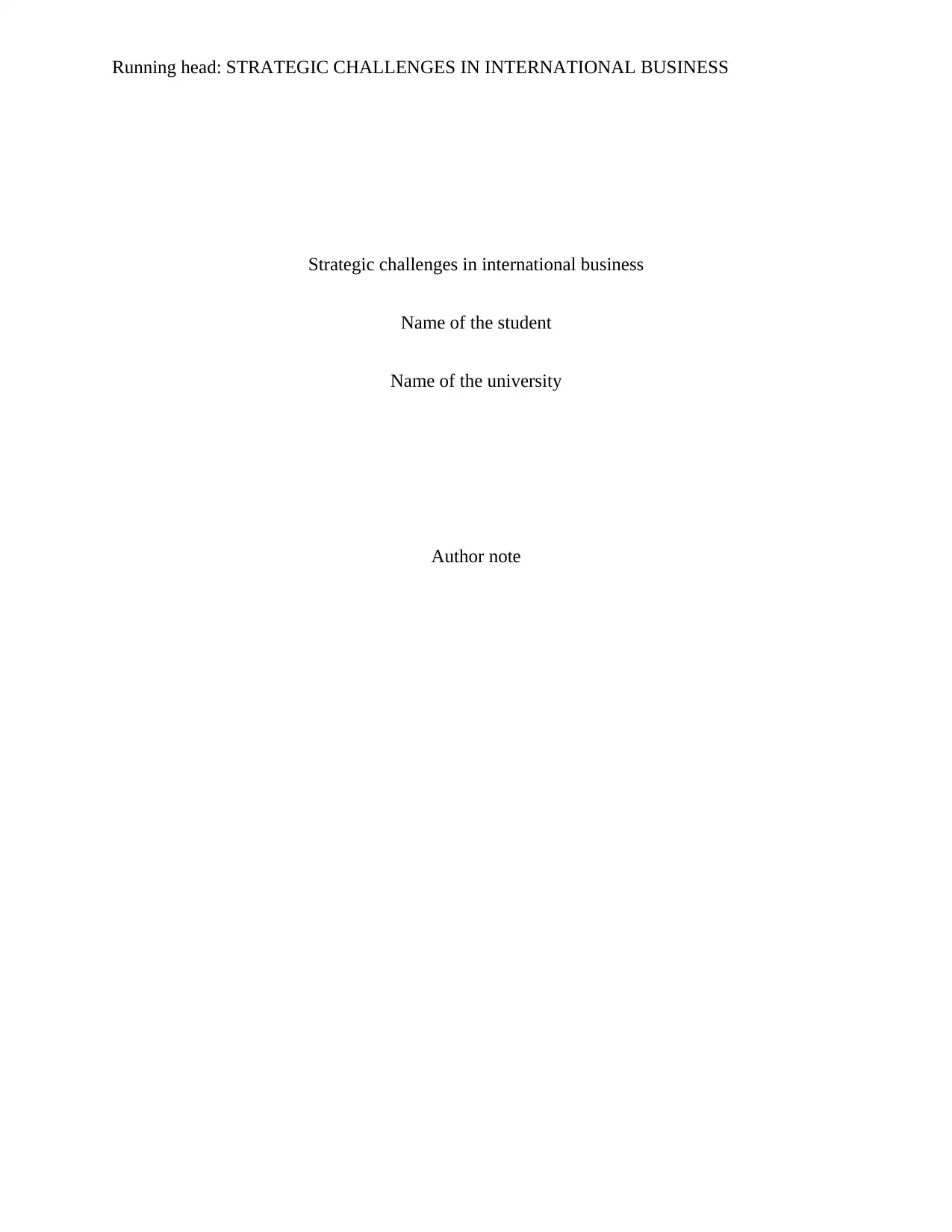
Running head: STRATEGIC CHALLENGES IN INTERNATIONAL BUSINESS
Strategic challenges in international business
Name of the student
Name of the university
Author note
Strategic challenges in international business
Name of the student
Name of the university
Author note
Paraphrase This Document
Need a fresh take? Get an instant paraphrase of this document with our AI Paraphraser
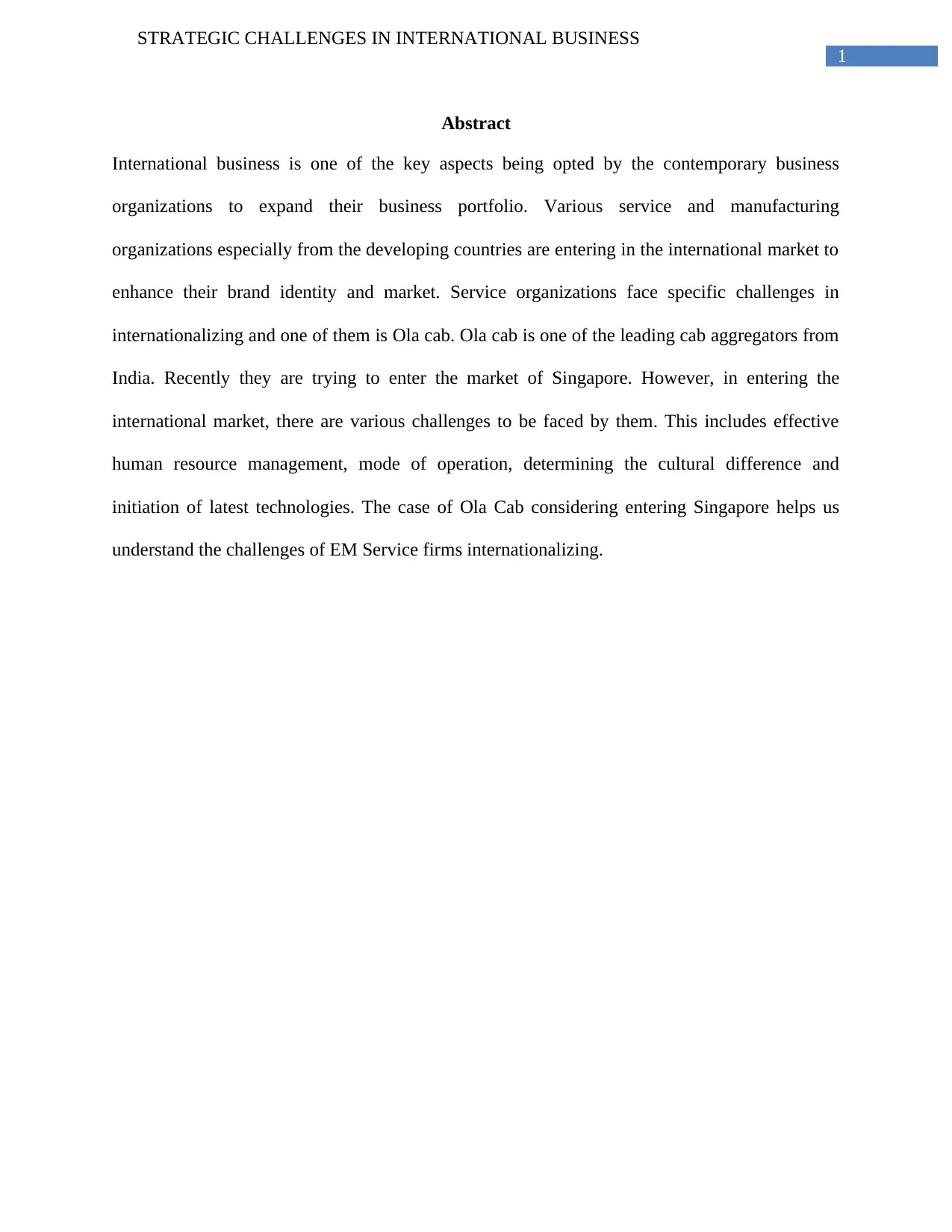
1
STRATEGIC CHALLENGES IN INTERNATIONAL BUSINESS
Abstract
International business is one of the key aspects being opted by the contemporary business
organizations to expand their business portfolio. Various service and manufacturing
organizations especially from the developing countries are entering in the international market to
enhance their brand identity and market. Service organizations face specific challenges in
internationalizing and one of them is Ola cab. Ola cab is one of the leading cab aggregators from
India. Recently they are trying to enter the market of Singapore. However, in entering the
international market, there are various challenges to be faced by them. This includes effective
human resource management, mode of operation, determining the cultural difference and
initiation of latest technologies. The case of Ola Cab considering entering Singapore helps us
understand the challenges of EM Service firms internationalizing.
STRATEGIC CHALLENGES IN INTERNATIONAL BUSINESS
Abstract
International business is one of the key aspects being opted by the contemporary business
organizations to expand their business portfolio. Various service and manufacturing
organizations especially from the developing countries are entering in the international market to
enhance their brand identity and market. Service organizations face specific challenges in
internationalizing and one of them is Ola cab. Ola cab is one of the leading cab aggregators from
India. Recently they are trying to enter the market of Singapore. However, in entering the
international market, there are various challenges to be faced by them. This includes effective
human resource management, mode of operation, determining the cultural difference and
initiation of latest technologies. The case of Ola Cab considering entering Singapore helps us
understand the challenges of EM Service firms internationalizing.
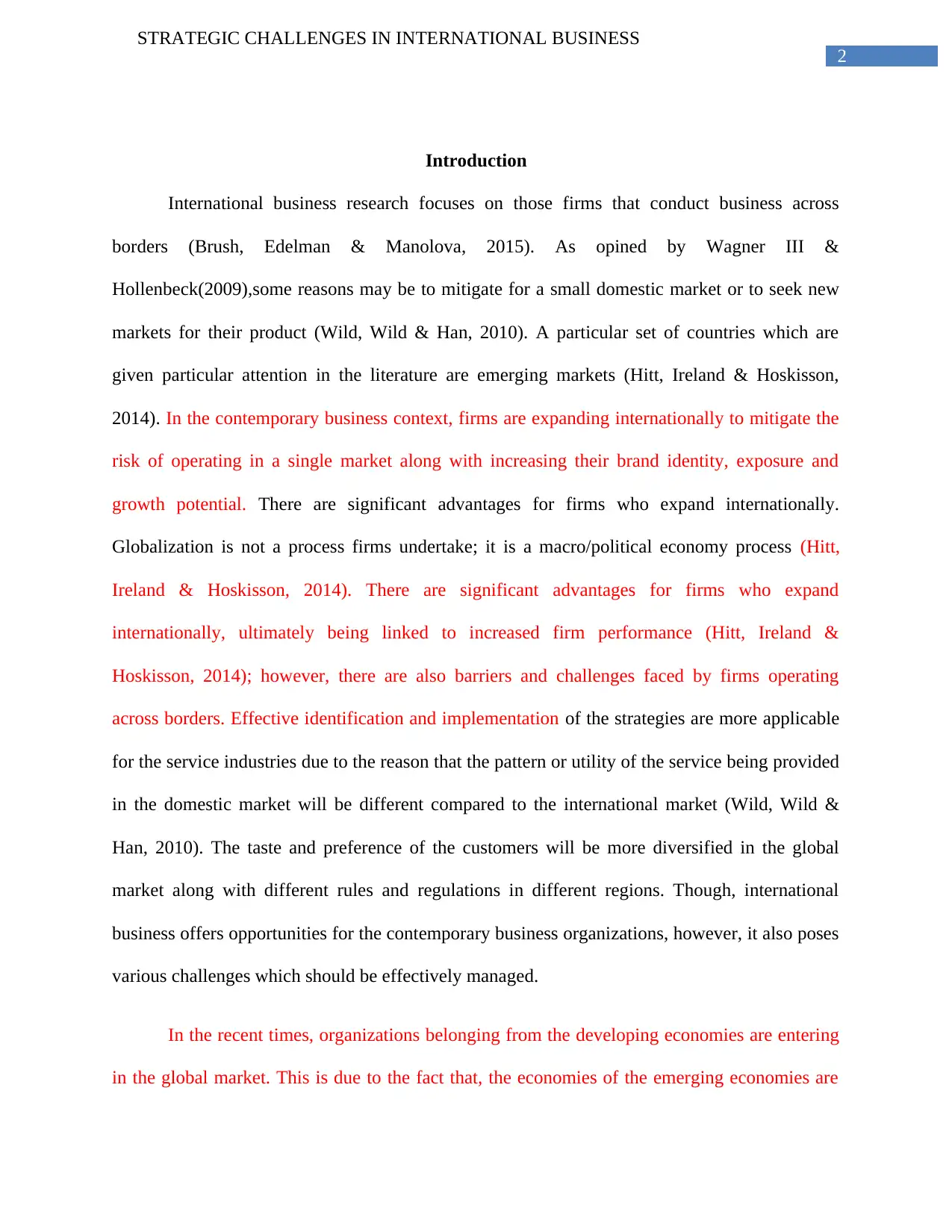
2
STRATEGIC CHALLENGES IN INTERNATIONAL BUSINESS
Introduction
International business research focuses on those firms that conduct business across
borders (Brush, Edelman & Manolova, 2015). As opined by Wagner III &
Hollenbeck(2009),some reasons may be to mitigate for a small domestic market or to seek new
markets for their product (Wild, Wild & Han, 2010). A particular set of countries which are
given particular attention in the literature are emerging markets (Hitt, Ireland & Hoskisson,
2014). In the contemporary business context, firms are expanding internationally to mitigate the
risk of operating in a single market along with increasing their brand identity, exposure and
growth potential. There are significant advantages for firms who expand internationally.
Globalization is not a process firms undertake; it is a macro/political economy process (Hitt,
Ireland & Hoskisson, 2014). There are significant advantages for firms who expand
internationally, ultimately being linked to increased firm performance (Hitt, Ireland &
Hoskisson, 2014); however, there are also barriers and challenges faced by firms operating
across borders. Effective identification and implementation of the strategies are more applicable
for the service industries due to the reason that the pattern or utility of the service being provided
in the domestic market will be different compared to the international market (Wild, Wild &
Han, 2010). The taste and preference of the customers will be more diversified in the global
market along with different rules and regulations in different regions. Though, international
business offers opportunities for the contemporary business organizations, however, it also poses
various challenges which should be effectively managed.
In the recent times, organizations belonging from the developing economies are entering
in the global market. This is due to the fact that, the economies of the emerging economies are
STRATEGIC CHALLENGES IN INTERNATIONAL BUSINESS
Introduction
International business research focuses on those firms that conduct business across
borders (Brush, Edelman & Manolova, 2015). As opined by Wagner III &
Hollenbeck(2009),some reasons may be to mitigate for a small domestic market or to seek new
markets for their product (Wild, Wild & Han, 2010). A particular set of countries which are
given particular attention in the literature are emerging markets (Hitt, Ireland & Hoskisson,
2014). In the contemporary business context, firms are expanding internationally to mitigate the
risk of operating in a single market along with increasing their brand identity, exposure and
growth potential. There are significant advantages for firms who expand internationally.
Globalization is not a process firms undertake; it is a macro/political economy process (Hitt,
Ireland & Hoskisson, 2014). There are significant advantages for firms who expand
internationally, ultimately being linked to increased firm performance (Hitt, Ireland &
Hoskisson, 2014); however, there are also barriers and challenges faced by firms operating
across borders. Effective identification and implementation of the strategies are more applicable
for the service industries due to the reason that the pattern or utility of the service being provided
in the domestic market will be different compared to the international market (Wild, Wild &
Han, 2010). The taste and preference of the customers will be more diversified in the global
market along with different rules and regulations in different regions. Though, international
business offers opportunities for the contemporary business organizations, however, it also poses
various challenges which should be effectively managed.
In the recent times, organizations belonging from the developing economies are entering
in the global market. This is due to the fact that, the economies of the emerging economies are
⊘ This is a preview!⊘
Do you want full access?
Subscribe today to unlock all pages.

Trusted by 1+ million students worldwide
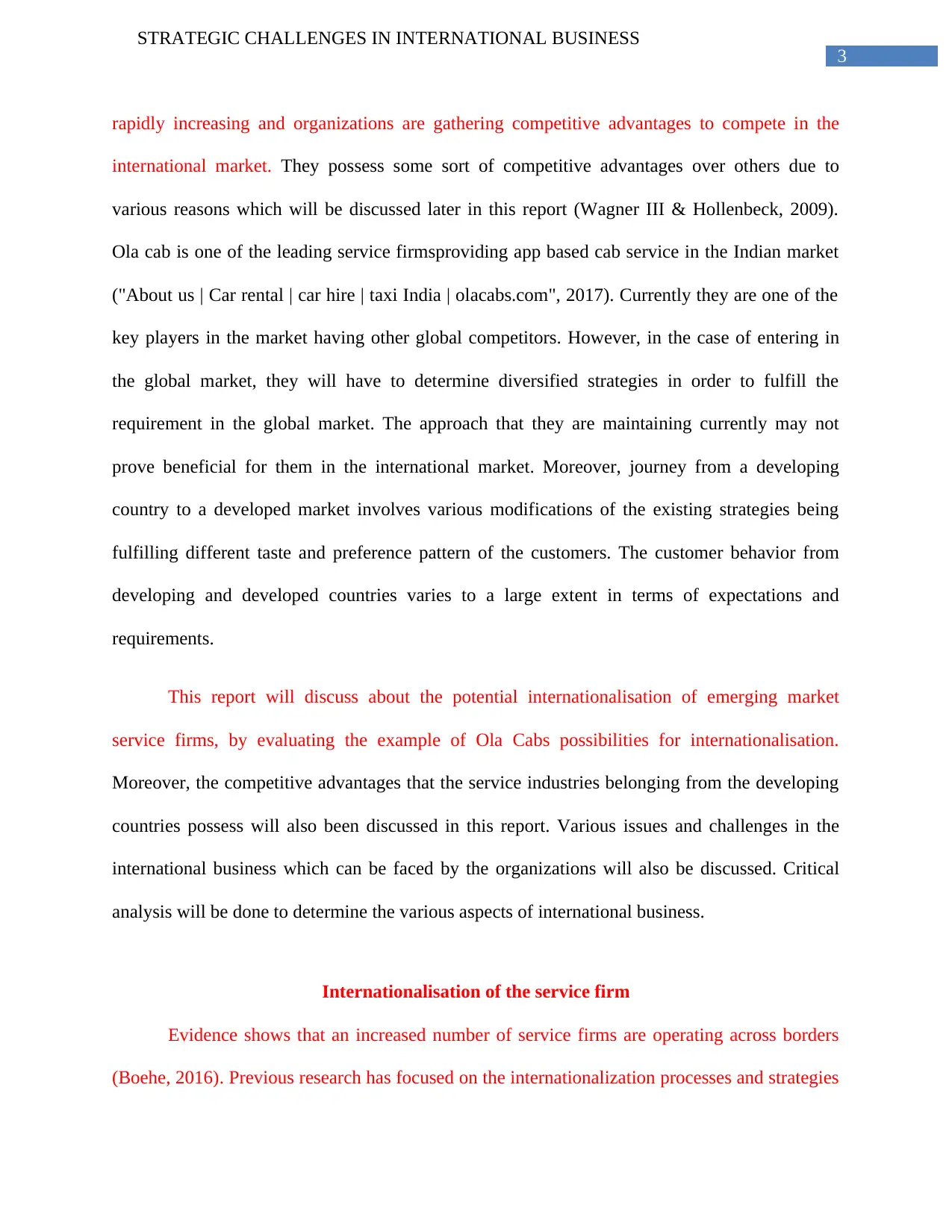
3
STRATEGIC CHALLENGES IN INTERNATIONAL BUSINESS
rapidly increasing and organizations are gathering competitive advantages to compete in the
international market. They possess some sort of competitive advantages over others due to
various reasons which will be discussed later in this report (Wagner III & Hollenbeck, 2009).
Ola cab is one of the leading service firmsproviding app based cab service in the Indian market
("About us | Car rental | car hire | taxi India | olacabs.com", 2017). Currently they are one of the
key players in the market having other global competitors. However, in the case of entering in
the global market, they will have to determine diversified strategies in order to fulfill the
requirement in the global market. The approach that they are maintaining currently may not
prove beneficial for them in the international market. Moreover, journey from a developing
country to a developed market involves various modifications of the existing strategies being
fulfilling different taste and preference pattern of the customers. The customer behavior from
developing and developed countries varies to a large extent in terms of expectations and
requirements.
This report will discuss about the potential internationalisation of emerging market
service firms, by evaluating the example of Ola Cabs possibilities for internationalisation.
Moreover, the competitive advantages that the service industries belonging from the developing
countries possess will also been discussed in this report. Various issues and challenges in the
international business which can be faced by the organizations will also be discussed. Critical
analysis will be done to determine the various aspects of international business.
Internationalisation of the service firm
Evidence shows that an increased number of service firms are operating across borders
(Boehe, 2016). Previous research has focused on the internationalization processes and strategies
STRATEGIC CHALLENGES IN INTERNATIONAL BUSINESS
rapidly increasing and organizations are gathering competitive advantages to compete in the
international market. They possess some sort of competitive advantages over others due to
various reasons which will be discussed later in this report (Wagner III & Hollenbeck, 2009).
Ola cab is one of the leading service firmsproviding app based cab service in the Indian market
("About us | Car rental | car hire | taxi India | olacabs.com", 2017). Currently they are one of the
key players in the market having other global competitors. However, in the case of entering in
the global market, they will have to determine diversified strategies in order to fulfill the
requirement in the global market. The approach that they are maintaining currently may not
prove beneficial for them in the international market. Moreover, journey from a developing
country to a developed market involves various modifications of the existing strategies being
fulfilling different taste and preference pattern of the customers. The customer behavior from
developing and developed countries varies to a large extent in terms of expectations and
requirements.
This report will discuss about the potential internationalisation of emerging market
service firms, by evaluating the example of Ola Cabs possibilities for internationalisation.
Moreover, the competitive advantages that the service industries belonging from the developing
countries possess will also been discussed in this report. Various issues and challenges in the
international business which can be faced by the organizations will also be discussed. Critical
analysis will be done to determine the various aspects of international business.
Internationalisation of the service firm
Evidence shows that an increased number of service firms are operating across borders
(Boehe, 2016). Previous research has focused on the internationalization processes and strategies
Paraphrase This Document
Need a fresh take? Get an instant paraphrase of this document with our AI Paraphraser
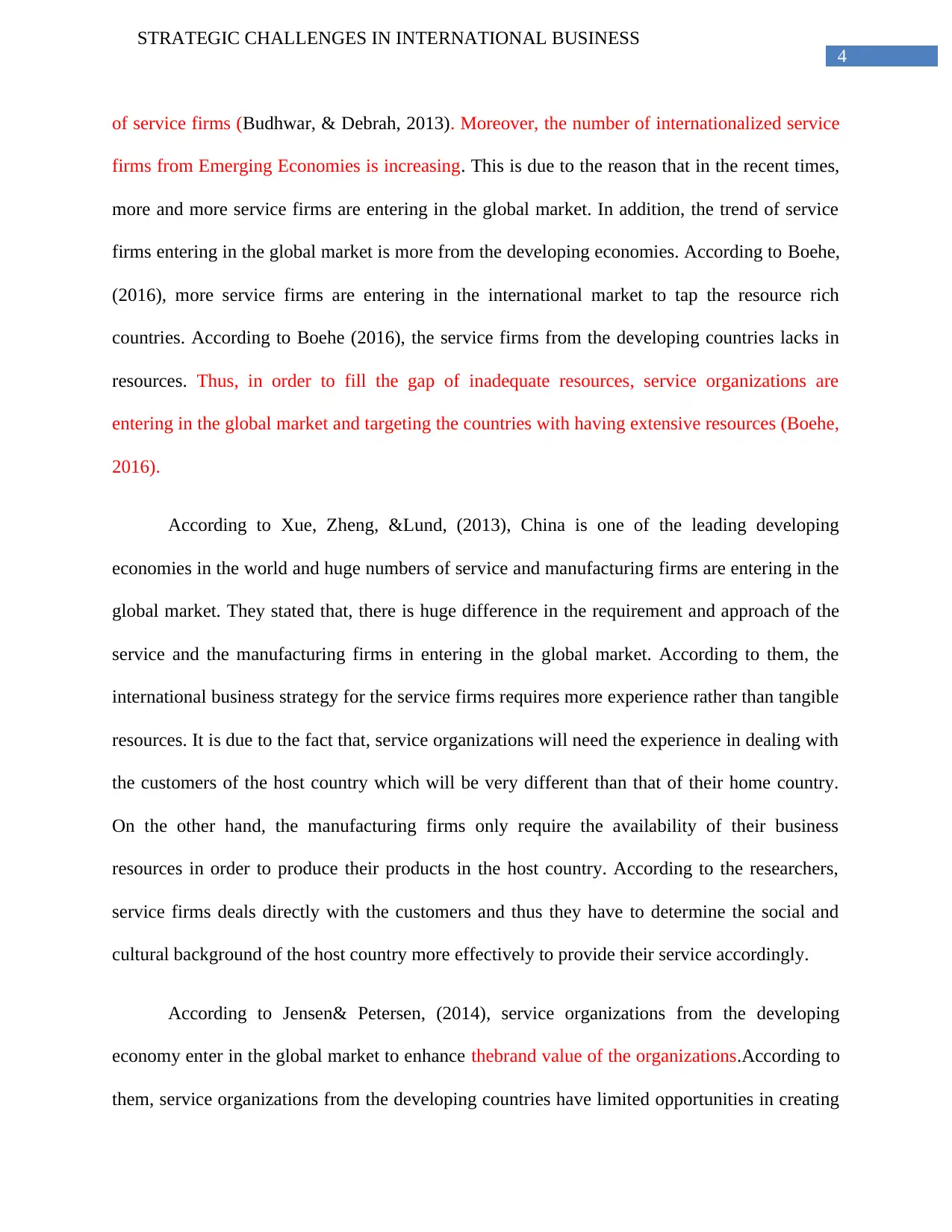
4
STRATEGIC CHALLENGES IN INTERNATIONAL BUSINESS
of service firms (Budhwar, & Debrah, 2013). Moreover, the number of internationalized service
firms from Emerging Economies is increasing. This is due to the reason that in the recent times,
more and more service firms are entering in the global market. In addition, the trend of service
firms entering in the global market is more from the developing economies. According to Boehe,
(2016), more service firms are entering in the international market to tap the resource rich
countries. According to Boehe (2016), the service firms from the developing countries lacks in
resources. Thus, in order to fill the gap of inadequate resources, service organizations are
entering in the global market and targeting the countries with having extensive resources (Boehe,
2016).
According to Xue, Zheng, &Lund, (2013), China is one of the leading developing
economies in the world and huge numbers of service and manufacturing firms are entering in the
global market. They stated that, there is huge difference in the requirement and approach of the
service and the manufacturing firms in entering in the global market. According to them, the
international business strategy for the service firms requires more experience rather than tangible
resources. It is due to the fact that, service organizations will need the experience in dealing with
the customers of the host country which will be very different than that of their home country.
On the other hand, the manufacturing firms only require the availability of their business
resources in order to produce their products in the host country. According to the researchers,
service firms deals directly with the customers and thus they have to determine the social and
cultural background of the host country more effectively to provide their service accordingly.
According to Jensen& Petersen, (2014), service organizations from the developing
economy enter in the global market to enhance thebrand value of the organizations.According to
them, service organizations from the developing countries have limited opportunities in creating
STRATEGIC CHALLENGES IN INTERNATIONAL BUSINESS
of service firms (Budhwar, & Debrah, 2013). Moreover, the number of internationalized service
firms from Emerging Economies is increasing. This is due to the reason that in the recent times,
more and more service firms are entering in the global market. In addition, the trend of service
firms entering in the global market is more from the developing economies. According to Boehe,
(2016), more service firms are entering in the international market to tap the resource rich
countries. According to Boehe (2016), the service firms from the developing countries lacks in
resources. Thus, in order to fill the gap of inadequate resources, service organizations are
entering in the global market and targeting the countries with having extensive resources (Boehe,
2016).
According to Xue, Zheng, &Lund, (2013), China is one of the leading developing
economies in the world and huge numbers of service and manufacturing firms are entering in the
global market. They stated that, there is huge difference in the requirement and approach of the
service and the manufacturing firms in entering in the global market. According to them, the
international business strategy for the service firms requires more experience rather than tangible
resources. It is due to the fact that, service organizations will need the experience in dealing with
the customers of the host country which will be very different than that of their home country.
On the other hand, the manufacturing firms only require the availability of their business
resources in order to produce their products in the host country. According to the researchers,
service firms deals directly with the customers and thus they have to determine the social and
cultural background of the host country more effectively to provide their service accordingly.
According to Jensen& Petersen, (2014), service organizations from the developing
economy enter in the global market to enhance thebrand value of the organizations.According to
them, service organizations from the developing countries have limited opportunities in creating
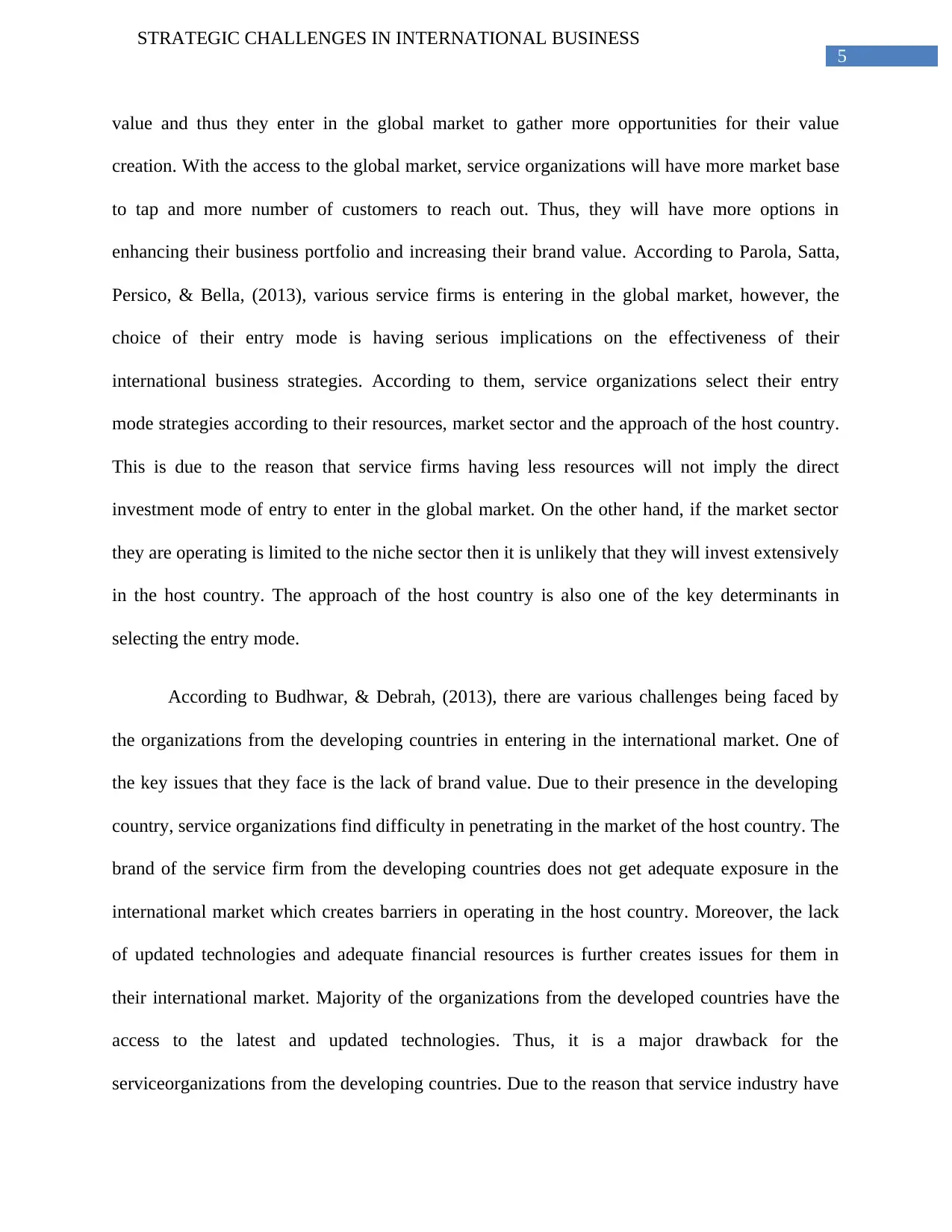
5
STRATEGIC CHALLENGES IN INTERNATIONAL BUSINESS
value and thus they enter in the global market to gather more opportunities for their value
creation. With the access to the global market, service organizations will have more market base
to tap and more number of customers to reach out. Thus, they will have more options in
enhancing their business portfolio and increasing their brand value. According to Parola, Satta,
Persico, & Bella, (2013), various service firms is entering in the global market, however, the
choice of their entry mode is having serious implications on the effectiveness of their
international business strategies. According to them, service organizations select their entry
mode strategies according to their resources, market sector and the approach of the host country.
This is due to the reason that service firms having less resources will not imply the direct
investment mode of entry to enter in the global market. On the other hand, if the market sector
they are operating is limited to the niche sector then it is unlikely that they will invest extensively
in the host country. The approach of the host country is also one of the key determinants in
selecting the entry mode.
According to Budhwar, & Debrah, (2013), there are various challenges being faced by
the organizations from the developing countries in entering in the international market. One of
the key issues that they face is the lack of brand value. Due to their presence in the developing
country, service organizations find difficulty in penetrating in the market of the host country. The
brand of the service firm from the developing countries does not get adequate exposure in the
international market which creates barriers in operating in the host country. Moreover, the lack
of updated technologies and adequate financial resources is further creates issues for them in
their international market. Majority of the organizations from the developed countries have the
access to the latest and updated technologies. Thus, it is a major drawback for the
serviceorganizations from the developing countries. Due to the reason that service industry have
STRATEGIC CHALLENGES IN INTERNATIONAL BUSINESS
value and thus they enter in the global market to gather more opportunities for their value
creation. With the access to the global market, service organizations will have more market base
to tap and more number of customers to reach out. Thus, they will have more options in
enhancing their business portfolio and increasing their brand value. According to Parola, Satta,
Persico, & Bella, (2013), various service firms is entering in the global market, however, the
choice of their entry mode is having serious implications on the effectiveness of their
international business strategies. According to them, service organizations select their entry
mode strategies according to their resources, market sector and the approach of the host country.
This is due to the reason that service firms having less resources will not imply the direct
investment mode of entry to enter in the global market. On the other hand, if the market sector
they are operating is limited to the niche sector then it is unlikely that they will invest extensively
in the host country. The approach of the host country is also one of the key determinants in
selecting the entry mode.
According to Budhwar, & Debrah, (2013), there are various challenges being faced by
the organizations from the developing countries in entering in the international market. One of
the key issues that they face is the lack of brand value. Due to their presence in the developing
country, service organizations find difficulty in penetrating in the market of the host country. The
brand of the service firm from the developing countries does not get adequate exposure in the
international market which creates barriers in operating in the host country. Moreover, the lack
of updated technologies and adequate financial resources is further creates issues for them in
their international market. Majority of the organizations from the developed countries have the
access to the latest and updated technologies. Thus, it is a major drawback for the
serviceorganizations from the developing countries. Due to the reason that service industry have
⊘ This is a preview!⊘
Do you want full access?
Subscribe today to unlock all pages.

Trusted by 1+ million students worldwide
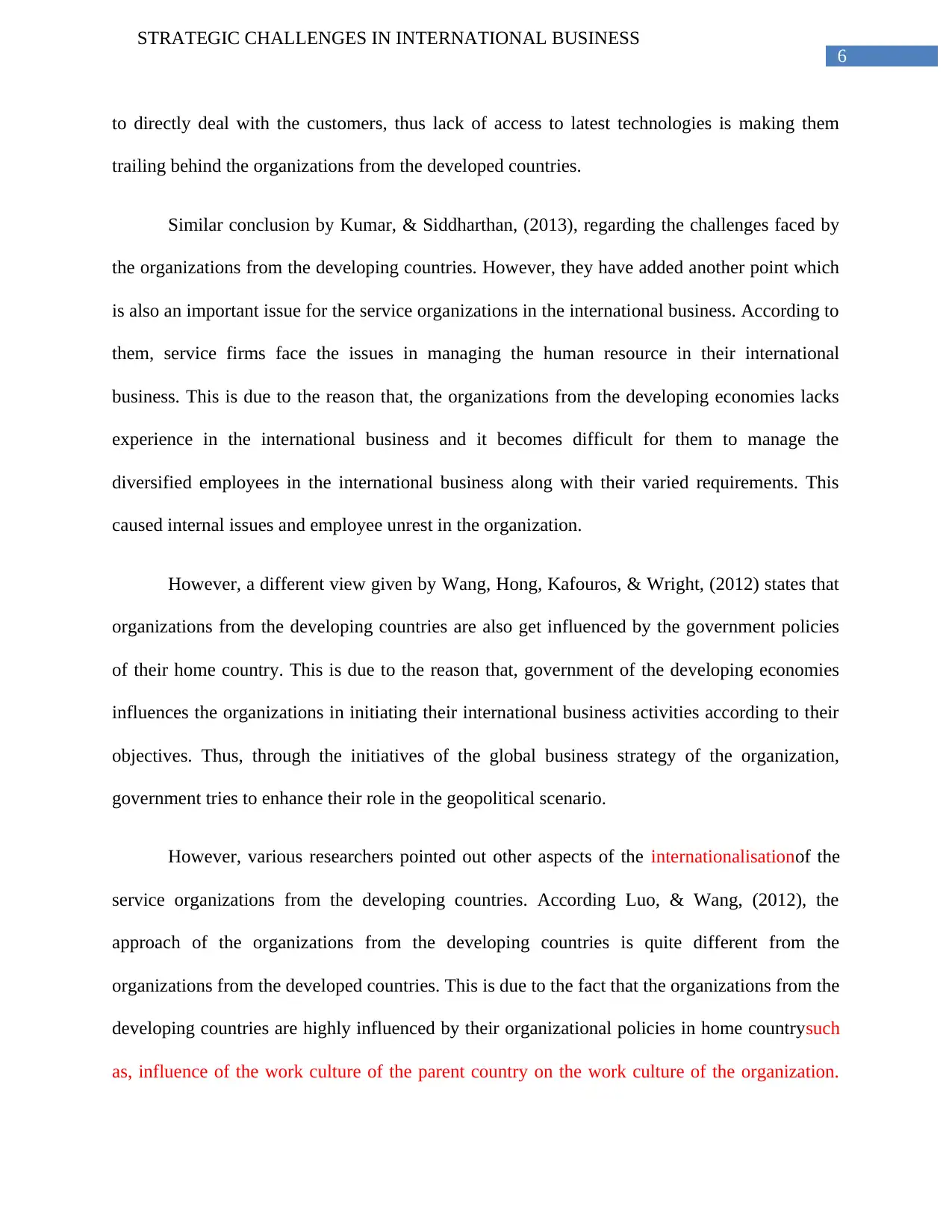
6
STRATEGIC CHALLENGES IN INTERNATIONAL BUSINESS
to directly deal with the customers, thus lack of access to latest technologies is making them
trailing behind the organizations from the developed countries.
Similar conclusion by Kumar, & Siddharthan, (2013), regarding the challenges faced by
the organizations from the developing countries. However, they have added another point which
is also an important issue for the service organizations in the international business. According to
them, service firms face the issues in managing the human resource in their international
business. This is due to the reason that, the organizations from the developing economies lacks
experience in the international business and it becomes difficult for them to manage the
diversified employees in the international business along with their varied requirements. This
caused internal issues and employee unrest in the organization.
However, a different view given by Wang, Hong, Kafouros, & Wright, (2012) states that
organizations from the developing countries are also get influenced by the government policies
of their home country. This is due to the reason that, government of the developing economies
influences the organizations in initiating their international business activities according to their
objectives. Thus, through the initiatives of the global business strategy of the organization,
government tries to enhance their role in the geopolitical scenario.
However, various researchers pointed out other aspects of the internationalisationof the
service organizations from the developing countries. According Luo, & Wang, (2012), the
approach of the organizations from the developing countries is quite different from the
organizations from the developed countries. This is due to the fact that the organizations from the
developing countries are highly influenced by their organizational policies in home countrysuch
as, influence of the work culture of the parent country on the work culture of the organization.
STRATEGIC CHALLENGES IN INTERNATIONAL BUSINESS
to directly deal with the customers, thus lack of access to latest technologies is making them
trailing behind the organizations from the developed countries.
Similar conclusion by Kumar, & Siddharthan, (2013), regarding the challenges faced by
the organizations from the developing countries. However, they have added another point which
is also an important issue for the service organizations in the international business. According to
them, service firms face the issues in managing the human resource in their international
business. This is due to the reason that, the organizations from the developing economies lacks
experience in the international business and it becomes difficult for them to manage the
diversified employees in the international business along with their varied requirements. This
caused internal issues and employee unrest in the organization.
However, a different view given by Wang, Hong, Kafouros, & Wright, (2012) states that
organizations from the developing countries are also get influenced by the government policies
of their home country. This is due to the reason that, government of the developing economies
influences the organizations in initiating their international business activities according to their
objectives. Thus, through the initiatives of the global business strategy of the organization,
government tries to enhance their role in the geopolitical scenario.
However, various researchers pointed out other aspects of the internationalisationof the
service organizations from the developing countries. According Luo, & Wang, (2012), the
approach of the organizations from the developing countries is quite different from the
organizations from the developed countries. This is due to the fact that the organizations from the
developing countries are highly influenced by their organizational policies in home countrysuch
as, influence of the work culture of the parent country on the work culture of the organization.
Paraphrase This Document
Need a fresh take? Get an instant paraphrase of this document with our AI Paraphraser
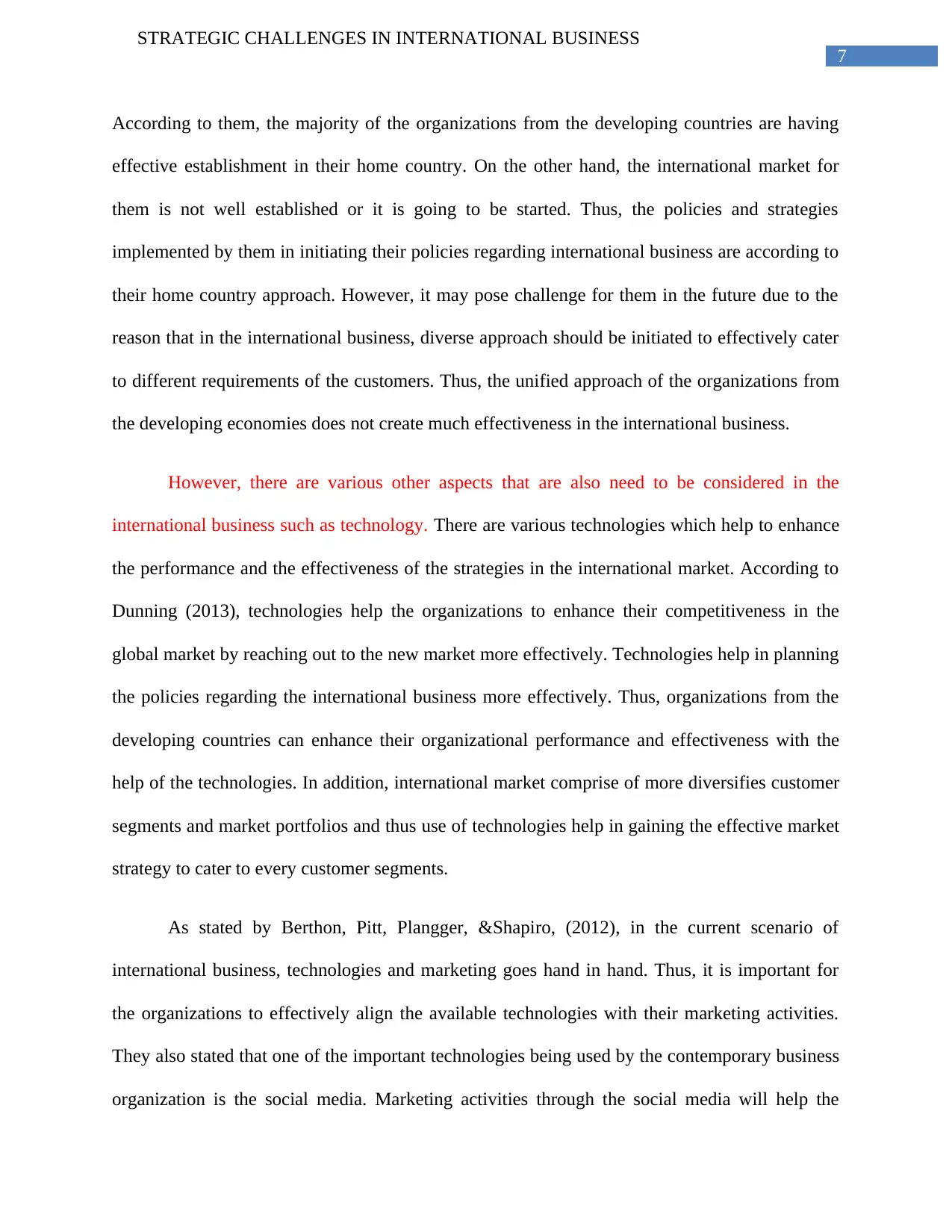
7
STRATEGIC CHALLENGES IN INTERNATIONAL BUSINESS
According to them, the majority of the organizations from the developing countries are having
effective establishment in their home country. On the other hand, the international market for
them is not well established or it is going to be started. Thus, the policies and strategies
implemented by them in initiating their policies regarding international business are according to
their home country approach. However, it may pose challenge for them in the future due to the
reason that in the international business, diverse approach should be initiated to effectively cater
to different requirements of the customers. Thus, the unified approach of the organizations from
the developing economies does not create much effectiveness in the international business.
However, there are various other aspects that are also need to be considered in the
international business such as technology. There are various technologies which help to enhance
the performance and the effectiveness of the strategies in the international market. According to
Dunning (2013), technologies help the organizations to enhance their competitiveness in the
global market by reaching out to the new market more effectively. Technologies help in planning
the policies regarding the international business more effectively. Thus, organizations from the
developing countries can enhance their organizational performance and effectiveness with the
help of the technologies. In addition, international market comprise of more diversifies customer
segments and market portfolios and thus use of technologies help in gaining the effective market
strategy to cater to every customer segments.
As stated by Berthon, Pitt, Plangger, &Shapiro, (2012), in the current scenario of
international business, technologies and marketing goes hand in hand. Thus, it is important for
the organizations to effectively align the available technologies with their marketing activities.
They also stated that one of the important technologies being used by the contemporary business
organization is the social media. Marketing activities through the social media will help the
STRATEGIC CHALLENGES IN INTERNATIONAL BUSINESS
According to them, the majority of the organizations from the developing countries are having
effective establishment in their home country. On the other hand, the international market for
them is not well established or it is going to be started. Thus, the policies and strategies
implemented by them in initiating their policies regarding international business are according to
their home country approach. However, it may pose challenge for them in the future due to the
reason that in the international business, diverse approach should be initiated to effectively cater
to different requirements of the customers. Thus, the unified approach of the organizations from
the developing economies does not create much effectiveness in the international business.
However, there are various other aspects that are also need to be considered in the
international business such as technology. There are various technologies which help to enhance
the performance and the effectiveness of the strategies in the international market. According to
Dunning (2013), technologies help the organizations to enhance their competitiveness in the
global market by reaching out to the new market more effectively. Technologies help in planning
the policies regarding the international business more effectively. Thus, organizations from the
developing countries can enhance their organizational performance and effectiveness with the
help of the technologies. In addition, international market comprise of more diversifies customer
segments and market portfolios and thus use of technologies help in gaining the effective market
strategy to cater to every customer segments.
As stated by Berthon, Pitt, Plangger, &Shapiro, (2012), in the current scenario of
international business, technologies and marketing goes hand in hand. Thus, it is important for
the organizations to effectively align the available technologies with their marketing activities.
They also stated that one of the important technologies being used by the contemporary business
organization is the social media. Marketing activities through the social media will help the
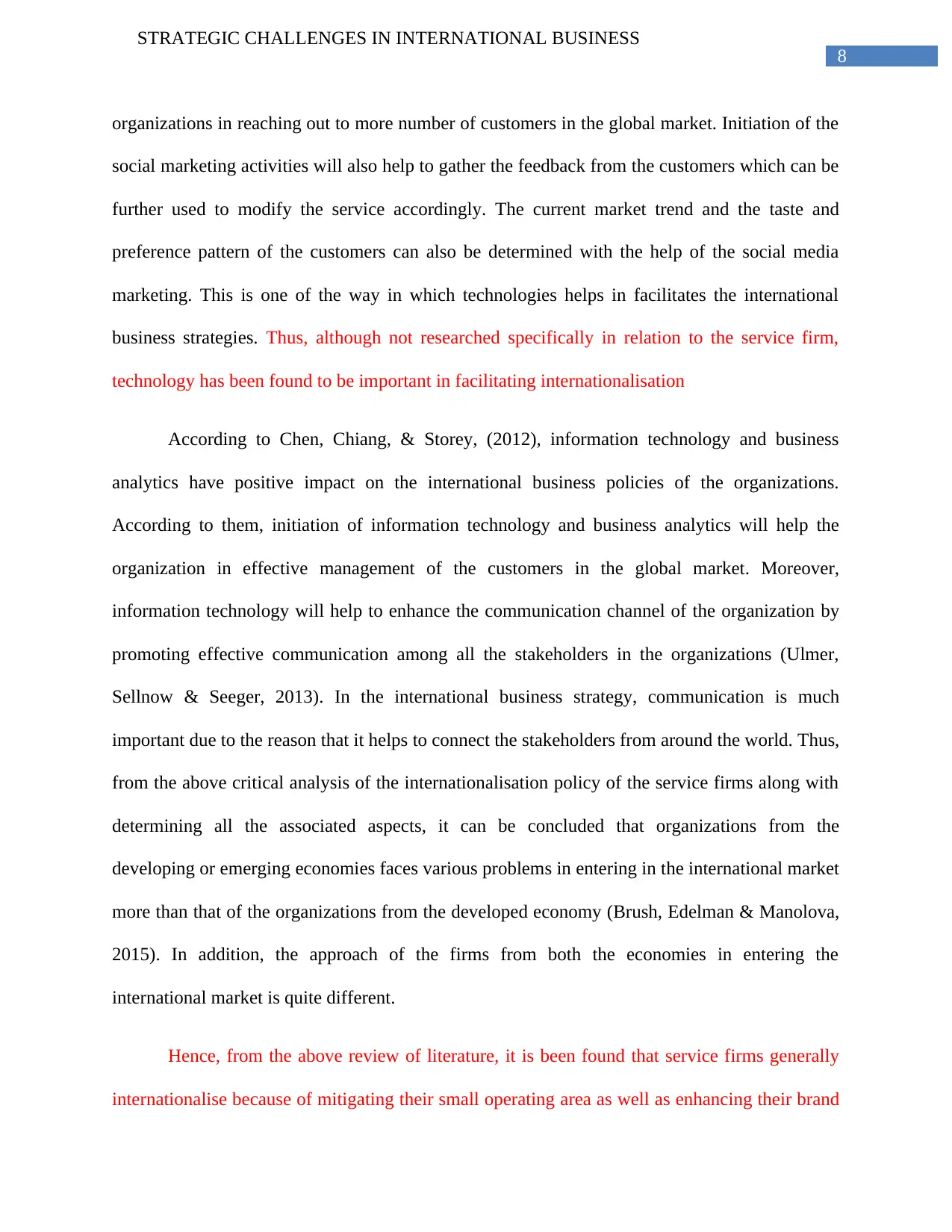
8
STRATEGIC CHALLENGES IN INTERNATIONAL BUSINESS
organizations in reaching out to more number of customers in the global market. Initiation of the
social marketing activities will also help to gather the feedback from the customers which can be
further used to modify the service accordingly. The current market trend and the taste and
preference pattern of the customers can also be determined with the help of the social media
marketing. This is one of the way in which technologies helps in facilitates the international
business strategies. Thus, although not researched specifically in relation to the service firm,
technology has been found to be important in facilitating internationalisation
According to Chen, Chiang, & Storey, (2012), information technology and business
analytics have positive impact on the international business policies of the organizations.
According to them, initiation of information technology and business analytics will help the
organization in effective management of the customers in the global market. Moreover,
information technology will help to enhance the communication channel of the organization by
promoting effective communication among all the stakeholders in the organizations (Ulmer,
Sellnow & Seeger, 2013). In the international business strategy, communication is much
important due to the reason that it helps to connect the stakeholders from around the world. Thus,
from the above critical analysis of the internationalisation policy of the service firms along with
determining all the associated aspects, it can be concluded that organizations from the
developing or emerging economies faces various problems in entering in the international market
more than that of the organizations from the developed economy (Brush, Edelman & Manolova,
2015). In addition, the approach of the firms from both the economies in entering the
international market is quite different.
Hence, from the above review of literature, it is been found that service firms generally
internationalise because of mitigating their small operating area as well as enhancing their brand
STRATEGIC CHALLENGES IN INTERNATIONAL BUSINESS
organizations in reaching out to more number of customers in the global market. Initiation of the
social marketing activities will also help to gather the feedback from the customers which can be
further used to modify the service accordingly. The current market trend and the taste and
preference pattern of the customers can also be determined with the help of the social media
marketing. This is one of the way in which technologies helps in facilitates the international
business strategies. Thus, although not researched specifically in relation to the service firm,
technology has been found to be important in facilitating internationalisation
According to Chen, Chiang, & Storey, (2012), information technology and business
analytics have positive impact on the international business policies of the organizations.
According to them, initiation of information technology and business analytics will help the
organization in effective management of the customers in the global market. Moreover,
information technology will help to enhance the communication channel of the organization by
promoting effective communication among all the stakeholders in the organizations (Ulmer,
Sellnow & Seeger, 2013). In the international business strategy, communication is much
important due to the reason that it helps to connect the stakeholders from around the world. Thus,
from the above critical analysis of the internationalisation policy of the service firms along with
determining all the associated aspects, it can be concluded that organizations from the
developing or emerging economies faces various problems in entering in the international market
more than that of the organizations from the developed economy (Brush, Edelman & Manolova,
2015). In addition, the approach of the firms from both the economies in entering the
international market is quite different.
Hence, from the above review of literature, it is been found that service firms generally
internationalise because of mitigating their small operating area as well as enhancing their brand
⊘ This is a preview!⊘
Do you want full access?
Subscribe today to unlock all pages.

Trusted by 1+ million students worldwide
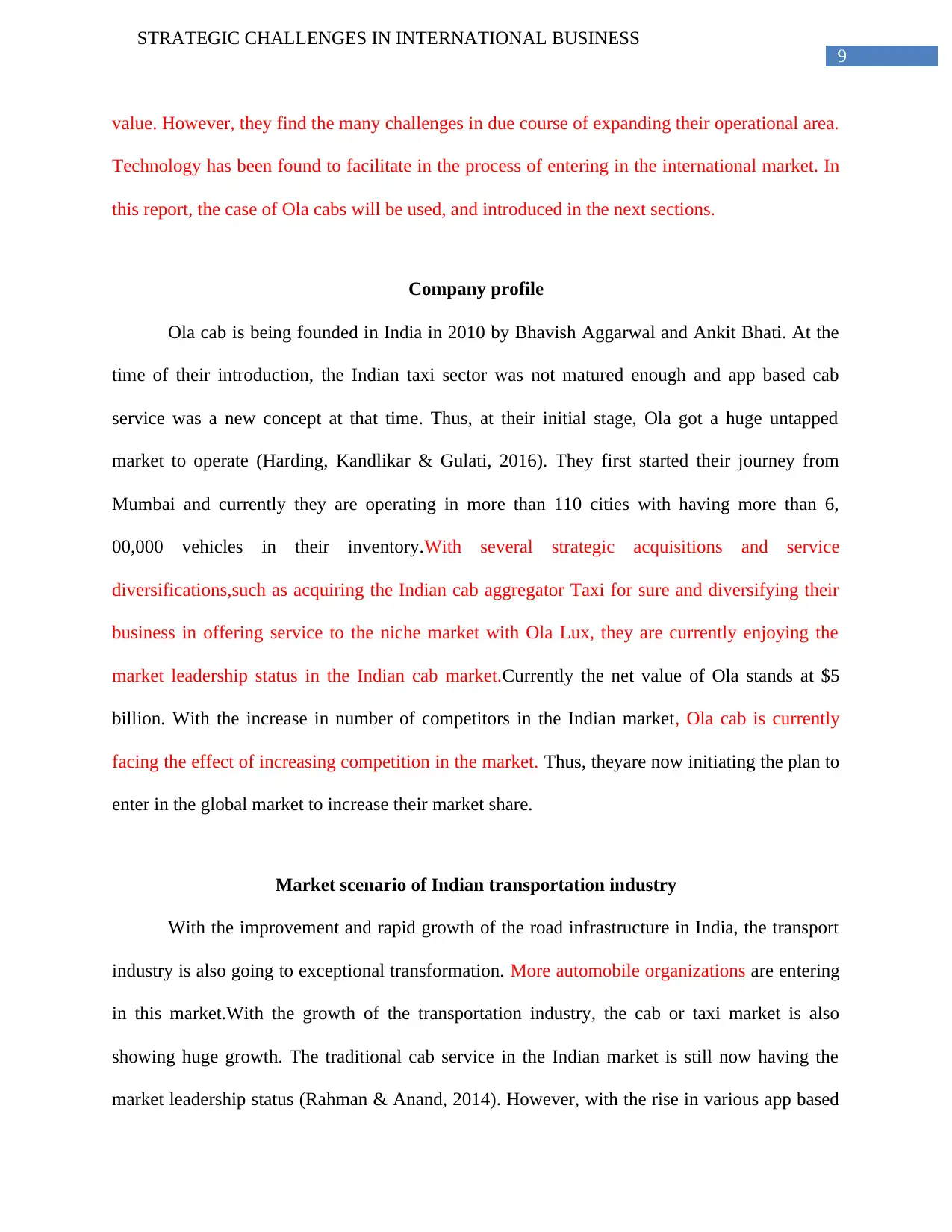
9
STRATEGIC CHALLENGES IN INTERNATIONAL BUSINESS
value. However, they find the many challenges in due course of expanding their operational area.
Technology has been found to facilitate in the process of entering in the international market. In
this report, the case of Ola cabs will be used, and introduced in the next sections.
Company profile
Ola cab is being founded in India in 2010 by Bhavish Aggarwal and Ankit Bhati. At the
time of their introduction, the Indian taxi sector was not matured enough and app based cab
service was a new concept at that time. Thus, at their initial stage, Ola got a huge untapped
market to operate (Harding, Kandlikar & Gulati, 2016). They first started their journey from
Mumbai and currently they are operating in more than 110 cities with having more than 6,
00,000 vehicles in their inventory.With several strategic acquisitions and service
diversifications,such as acquiring the Indian cab aggregator Taxi for sure and diversifying their
business in offering service to the niche market with Ola Lux, they are currently enjoying the
market leadership status in the Indian cab market.Currently the net value of Ola stands at $5
billion. With the increase in number of competitors in the Indian market, Ola cab is currently
facing the effect of increasing competition in the market. Thus, theyare now initiating the plan to
enter in the global market to increase their market share.
Market scenario of Indian transportation industry
With the improvement and rapid growth of the road infrastructure in India, the transport
industry is also going to exceptional transformation. More automobile organizations are entering
in this market.With the growth of the transportation industry, the cab or taxi market is also
showing huge growth. The traditional cab service in the Indian market is still now having the
market leadership status (Rahman & Anand, 2014). However, with the rise in various app based
STRATEGIC CHALLENGES IN INTERNATIONAL BUSINESS
value. However, they find the many challenges in due course of expanding their operational area.
Technology has been found to facilitate in the process of entering in the international market. In
this report, the case of Ola cabs will be used, and introduced in the next sections.
Company profile
Ola cab is being founded in India in 2010 by Bhavish Aggarwal and Ankit Bhati. At the
time of their introduction, the Indian taxi sector was not matured enough and app based cab
service was a new concept at that time. Thus, at their initial stage, Ola got a huge untapped
market to operate (Harding, Kandlikar & Gulati, 2016). They first started their journey from
Mumbai and currently they are operating in more than 110 cities with having more than 6,
00,000 vehicles in their inventory.With several strategic acquisitions and service
diversifications,such as acquiring the Indian cab aggregator Taxi for sure and diversifying their
business in offering service to the niche market with Ola Lux, they are currently enjoying the
market leadership status in the Indian cab market.Currently the net value of Ola stands at $5
billion. With the increase in number of competitors in the Indian market, Ola cab is currently
facing the effect of increasing competition in the market. Thus, theyare now initiating the plan to
enter in the global market to increase their market share.
Market scenario of Indian transportation industry
With the improvement and rapid growth of the road infrastructure in India, the transport
industry is also going to exceptional transformation. More automobile organizations are entering
in this market.With the growth of the transportation industry, the cab or taxi market is also
showing huge growth. The traditional cab service in the Indian market is still now having the
market leadership status (Rahman & Anand, 2014). However, with the rise in various app based
Paraphrase This Document
Need a fresh take? Get an instant paraphrase of this document with our AI Paraphraser
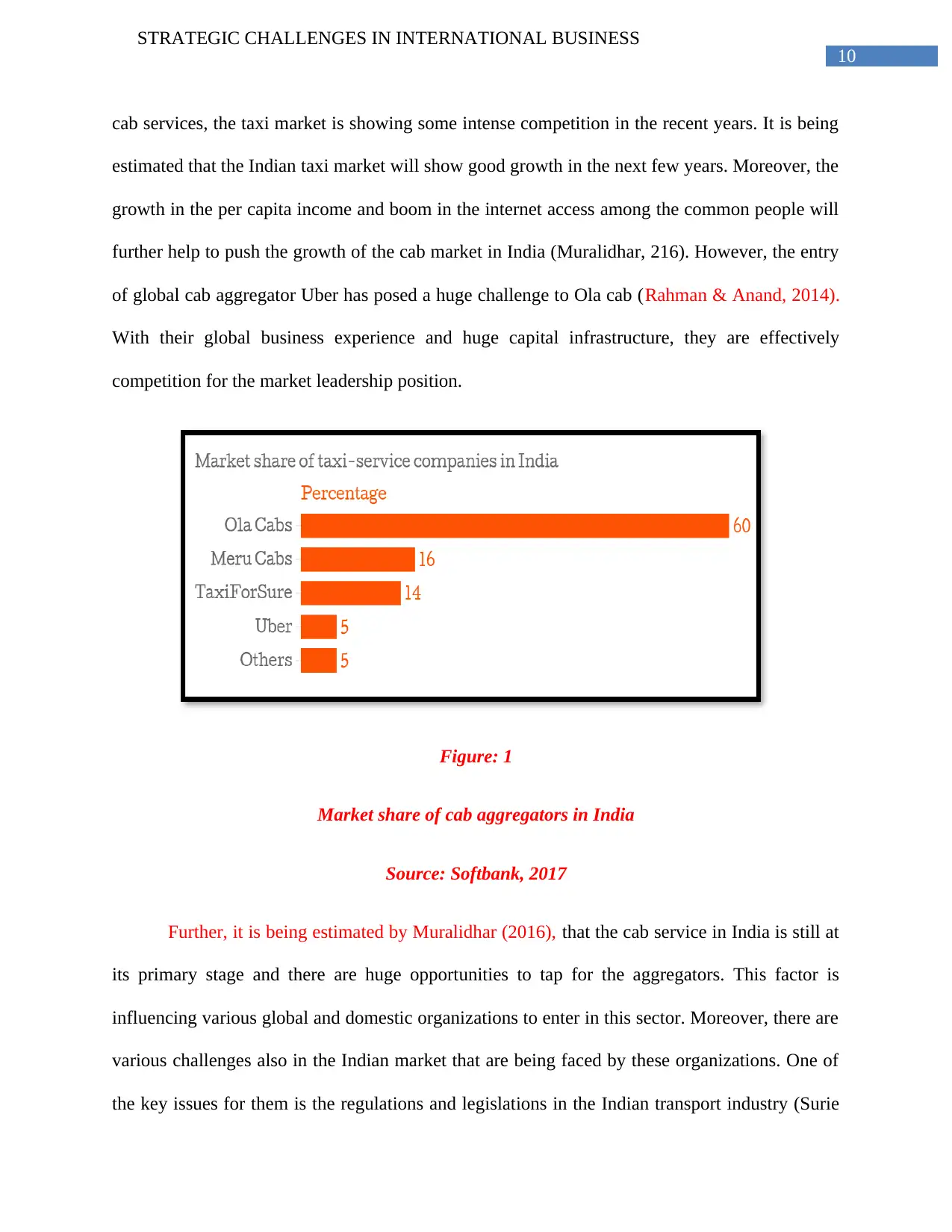
10
STRATEGIC CHALLENGES IN INTERNATIONAL BUSINESS
cab services, the taxi market is showing some intense competition in the recent years. It is being
estimated that the Indian taxi market will show good growth in the next few years. Moreover, the
growth in the per capita income and boom in the internet access among the common people will
further help to push the growth of the cab market in India (Muralidhar, 216). However, the entry
of global cab aggregator Uber has posed a huge challenge to Ola cab (Rahman & Anand, 2014).
With their global business experience and huge capital infrastructure, they are effectively
competition for the market leadership position.
Figure: 1
Market share of cab aggregators in India
Source: Softbank, 2017
Further, it is being estimated by Muralidhar (2016), that the cab service in India is still at
its primary stage and there are huge opportunities to tap for the aggregators. This factor is
influencing various global and domestic organizations to enter in this sector. Moreover, there are
various challenges also in the Indian market that are being faced by these organizations. One of
the key issues for them is the regulations and legislations in the Indian transport industry (Surie
STRATEGIC CHALLENGES IN INTERNATIONAL BUSINESS
cab services, the taxi market is showing some intense competition in the recent years. It is being
estimated that the Indian taxi market will show good growth in the next few years. Moreover, the
growth in the per capita income and boom in the internet access among the common people will
further help to push the growth of the cab market in India (Muralidhar, 216). However, the entry
of global cab aggregator Uber has posed a huge challenge to Ola cab (Rahman & Anand, 2014).
With their global business experience and huge capital infrastructure, they are effectively
competition for the market leadership position.
Figure: 1
Market share of cab aggregators in India
Source: Softbank, 2017
Further, it is being estimated by Muralidhar (2016), that the cab service in India is still at
its primary stage and there are huge opportunities to tap for the aggregators. This factor is
influencing various global and domestic organizations to enter in this sector. Moreover, there are
various challenges also in the Indian market that are being faced by these organizations. One of
the key issues for them is the regulations and legislations in the Indian transport industry (Surie
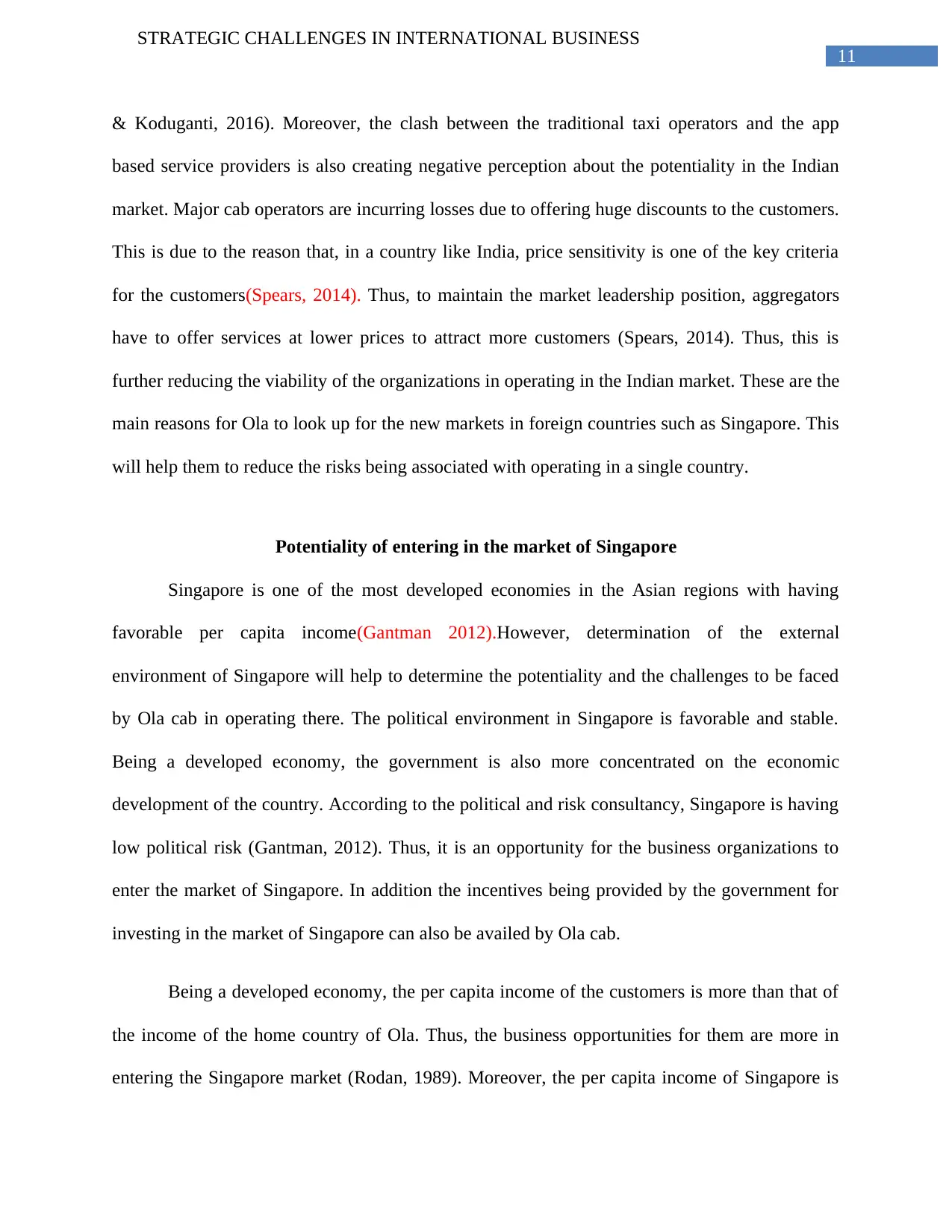
11
STRATEGIC CHALLENGES IN INTERNATIONAL BUSINESS
& Koduganti, 2016). Moreover, the clash between the traditional taxi operators and the app
based service providers is also creating negative perception about the potentiality in the Indian
market. Major cab operators are incurring losses due to offering huge discounts to the customers.
This is due to the reason that, in a country like India, price sensitivity is one of the key criteria
for the customers(Spears, 2014). Thus, to maintain the market leadership position, aggregators
have to offer services at lower prices to attract more customers (Spears, 2014). Thus, this is
further reducing the viability of the organizations in operating in the Indian market. These are the
main reasons for Ola to look up for the new markets in foreign countries such as Singapore. This
will help them to reduce the risks being associated with operating in a single country.
Potentiality of entering in the market of Singapore
Singapore is one of the most developed economies in the Asian regions with having
favorable per capita income(Gantman 2012).However, determination of the external
environment of Singapore will help to determine the potentiality and the challenges to be faced
by Ola cab in operating there. The political environment in Singapore is favorable and stable.
Being a developed economy, the government is also more concentrated on the economic
development of the country. According to the political and risk consultancy, Singapore is having
low political risk (Gantman, 2012). Thus, it is an opportunity for the business organizations to
enter the market of Singapore. In addition the incentives being provided by the government for
investing in the market of Singapore can also be availed by Ola cab.
Being a developed economy, the per capita income of the customers is more than that of
the income of the home country of Ola. Thus, the business opportunities for them are more in
entering the Singapore market (Rodan, 1989). Moreover, the per capita income of Singapore is
STRATEGIC CHALLENGES IN INTERNATIONAL BUSINESS
& Koduganti, 2016). Moreover, the clash between the traditional taxi operators and the app
based service providers is also creating negative perception about the potentiality in the Indian
market. Major cab operators are incurring losses due to offering huge discounts to the customers.
This is due to the reason that, in a country like India, price sensitivity is one of the key criteria
for the customers(Spears, 2014). Thus, to maintain the market leadership position, aggregators
have to offer services at lower prices to attract more customers (Spears, 2014). Thus, this is
further reducing the viability of the organizations in operating in the Indian market. These are the
main reasons for Ola to look up for the new markets in foreign countries such as Singapore. This
will help them to reduce the risks being associated with operating in a single country.
Potentiality of entering in the market of Singapore
Singapore is one of the most developed economies in the Asian regions with having
favorable per capita income(Gantman 2012).However, determination of the external
environment of Singapore will help to determine the potentiality and the challenges to be faced
by Ola cab in operating there. The political environment in Singapore is favorable and stable.
Being a developed economy, the government is also more concentrated on the economic
development of the country. According to the political and risk consultancy, Singapore is having
low political risk (Gantman, 2012). Thus, it is an opportunity for the business organizations to
enter the market of Singapore. In addition the incentives being provided by the government for
investing in the market of Singapore can also be availed by Ola cab.
Being a developed economy, the per capita income of the customers is more than that of
the income of the home country of Ola. Thus, the business opportunities for them are more in
entering the Singapore market (Rodan, 1989). Moreover, the per capita income of Singapore is
⊘ This is a preview!⊘
Do you want full access?
Subscribe today to unlock all pages.

Trusted by 1+ million students worldwide
1 out of 23
Related Documents
Your All-in-One AI-Powered Toolkit for Academic Success.
+13062052269
info@desklib.com
Available 24*7 on WhatsApp / Email
![[object Object]](/_next/static/media/star-bottom.7253800d.svg)
Unlock your academic potential
Copyright © 2020–2025 A2Z Services. All Rights Reserved. Developed and managed by ZUCOL.





